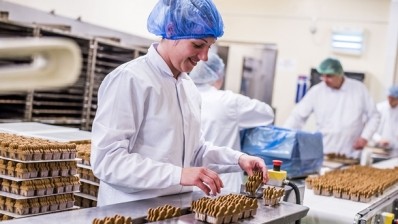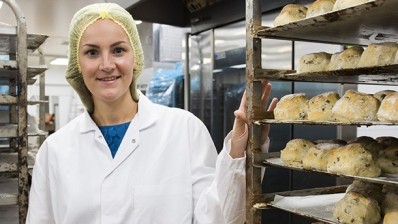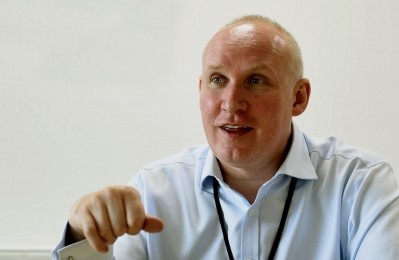Me and my factory
Sweet firm Kinnerton focuses on staff engagement

This factory mainly specialises in making chocolate-coated fruit and nut products, and chocolate-moulded eggs and balls, while the other Kinnerton site, in Fakenham, Norfolk, produces novelty and ‘character’ chocolate under license from the likes of Disney.
The Sherburn site was opened in 2003 by Horsley Hick & Flower – a company formed by three local entrepreneurs who remain active in the business today. In 2006, Kinnerton took over the business and doubled the size of the factory.
Five years later, they extended it to the present footprint, which is approximately 8,500m2.
I arrived as operations manager as part of the company’s ‘cultural change’ strategy for the site. My background has always been in the food industry, and I have experience of production and lean manufacturing roles at the likes of United Biscuits and McCain Foods.
Kinnerton had just been bought by a large German company, Zertus, and the idea was to move the business on from a ‘get it out the door’ mentality, towards one that could provide for the likes of Marks & Spencer and Tesco.
That’s not to knock that entrepreneurial spirit – it was just that the company was getting to the scale where it needed to develop.
Needed to develop (Back to top)
We have two areas within the factory. One-sixth of the site is dedicated to nut production, while the rest is nut-free.
Currently, we produce nuts on a three-shift pattern, and the nut-free area will be moving to a three-shift pattern at the end of July, which will help us cut down on a lot of overtime, and enable us to achieve greater throughput and a more balanced workload.
I think as a business, creating unnecessary change isn’t something we want to do. In the past, we would jump between shifts quite readily, but now we’re much more deliberate, as we don’t want to lose good staff along the way.
We’re a batch-orientated factory with four main production areas, and while we don’t actually manufacture the chocolate, there are a quite a few stages involved in the production process.
When the chocolate is pumped in, it’s in liquid form. We hold the chocolate at between 46–50°C, and then temper it at about 30°C. When we make the balls, for example, the chocolate is shock-frozen between a mould, before moving down a line, which knocks the edges off them.
They then go into a coating room where they are sprayed or coated in rotating steel or copper pans, which also smooth them out. Using pans might be more manual than belt coating, but they allow more for flexibility.
Cultural change strategy (Back to top)
Everything we do comes back to our cultural change strategy, which involves being much more collaborative with our employees.
Central to this is our ‘respect values’ campaign, which comprises a series of behavioural objectives for each individual. Some of the objectives, such as ‘improve communications’ and ‘be more confident’ are dotted around the factory walls.
Personal
Name: Mark Bullock
Age: 49
Domestics: I am married with three children and a dog!
Outside work: I tend to watch a lot of sport. I support Huddersfield Town FC they are currently in the Championship, so aren’t doing all that badly.
Greatest achievement: I would say it’s been implementing the cultural change at Sherburn, watching the team develop, and seeing this business unit become profitable.
Advice to younger self: Don’t worry too much about the future, take risks and have fun!
Initially, they were quite generic, but over time they have become more specific.
We have an employee engagement team that works closely with HR, making sure there’s minimum disruption to our business and staff.
That engagement team can also get involved in any improvements to the site, and transfer information back to the shop floor.
We try to give all our teams some teeth. For example, we had a team that worked on improving the canteen and picnic area, and we have ‘green’ teams that have been successful in working on our sustainability as a company, and we brought in a health and safety committee.
Every other week we also have ‘tea with the team’ briefing sessions, where staff can ask questions about anything on their mind.
Creating a bit more fun (Back to top)
The place had quite a cold feel to it when I arrived, so we were also keen on creating a bit more fun and building a family atmosphere. We host summer barbecues, go off-site for Christmas dinners, and have pizza-days when the company has performed well.
There are also staff awards for things like good achievement and going the extra mile. We have a bright ideas scheme as well, which rewards all participants with a bottle of wine, no matter how bright their idea might be.
Last year, someone came up with an idea that saved us £8,000, so the scheme more than paid for itself. At the very least, it’s a great way of finding out who the big drinkers in the company are!
Our next target is further upskilling of the shop floor. Our engineering department is still too reactive, for instance.
As part of this first wave, a number of staff – including engineers, managers and office-workers – are taking a BIT (Business Improvement Techniques) level 2 NVQ in manufacturing.
We want to build more expertise within the manufacturing team, so we can develop people to greenbelt and blackbelt levels in lean sigma. It’s a mixture of lean and six-sigma that we’re aiming to achieve.
The ultimate aim is to go from a top-down problem-solving organisation, to one that is responsible from the bottom-up. We are midway along the process, but hope to see some tangible benefits in this area soon.
Meanwhile, you can find out more about how Kinnerton’s Sherburn-in-Elmet site is starting to embrace lean manufacturing in FoodManufacture.co.uk’s exclusive video interview with Mark Bullock.
Factory facts
- Location: 4 Lincoln Way, Sherburn-in-Elmet, North Yorkshire, LS25 6PJ
- Size: 8,500m2
- Turnover: £17M (Sherburn-in-Elmet site)
- Staff: 150, plus an average of 20 agency workers.
- Average production speed: 400kg an hour.
- Factory output: 5,000t a year
















